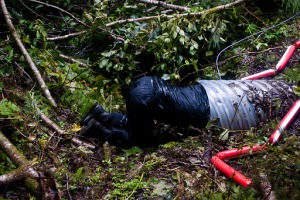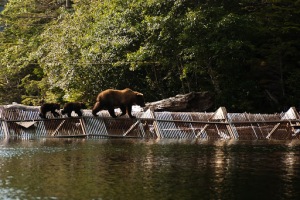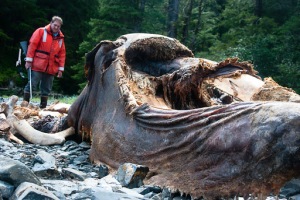My training has continued… I have now been certified for first aid and CPR, to ride an ATV, and yes, to exit underwater aircraft. I did not expect these trainings when I was signing up for a job in communications, even if it is communicating in Alaska. But I guess it is Southeast Alaska, the Panhandle, which is mostly made up of islands. Sitka, where I am living, and will be for the next six months, is on one of the three largest islands, the ABCs. Admiralty, Baranof, and Chichagoff. (Sitka is on Baranof. Baranof was in charge of the Russian American Company, way back when.) To go anywhere involves going over water, by boat or plane, and thus all the safety training.
Hypothermia you can go read about on your own, and you can take the same standardized first aid and CPR training anywhere in the country, but I bet you can’t get the underwater egress training, so I’ll talk about that one.
The training was run by Dug Jensen, who also did most of the water and survival trainings on the previous days. For this one, he also brought in a retired Coast Guard pilot and helicopter mechanic. We watched a video, and learned things like if a plane (including float planes) has its landing gear down when it hits the water, the gear catches and flips the plane. Boom, you are upside down and underwater.
One of the Forest Service folks who has been around for a while recounted how he narrowly missed being on a flight where this happened. The pilot was running a couple of loads of gear back and forth to a camp on a lake, and this guy needed to go back for something at the last minute, and so didn’t get on the plane. The pilot forgot the landing gear, and flipped. An unsecured propane tank from the back shot out the front window, directly through the passenger seat. Very lucky that he wasn’t sitting there! The pilot got out, and wasn’t able to convince the crew waiting at the camp that there was no passenger — they figured he was disoriented — and they dove in the lake to look for him for a while before it all got sorted out. This is just one of many war stories we have heard during the training period.
Anyway, we had the classroom portion of this training and then we divided into two groups for pool time. All the talk and anticipation was making me nervous about it, so I volunteered myself for the first group to get it over with.
At the pool, as I had heard, there was indeed a cage structure made of yellow PVC pipe, with a blue seat of laminated nylon sort of stuff in the middle, and a five point harness like you might have in a helicopter. You sit in the seat, and fasten up the harness, which has a release in the middle. You twist the release, either direction, and it all comes off immediately. You also wear a helmet, because you probably would in a helicopter or small plane, and be attached with some inflight communications system.
Here is what you practice.
1. Open your door, and lock the mechanism so it can’t relatch and trap you.
2. Undo any cords attaching you to the comms system.
3. Find a point of reference for your hand near the door.
4. Now, instead of leaving your hands on that point where your arm is rigid and could get broken, put them under your legs, or wrap them around you so your face is protected in the crook of your elbow. Don’t put your hand on the harness release, because you want to be strapped in at impact — that’s what the harness is there for!
5. Take a couple deep breaths before you hit the water, but not so many that you’re hyperventilating and will make yourself pass out. The instructor asks if you are ready. Say yes, and listen to the count of 1, 2, 3.
6. Now you’re in the water, upside down. Don’t flail around; stay calm and wait for the cage to settle. In a real crash, don’t wait so long that you are 300 feet below the surface, just long enough that the helicopter rotors or other dangerous moving debris is done.
7. Undo your harness.
8. Put your hand out to your reference point. From there grab another solid point, and so on until you are outside.
9. Head to the surface. Don’t kick anyone who is trying to get out behind you.
My first immersion I flailed a bit, but got out. The next two I was calmer and did fine, but not so well that they offered to tip me in backwards instead of forwards, although I did I have a simulated blocked exit (i.e. the Coastie splayed himself on the side I had been going out on) on the last one.
Throughout the practice, there were a couple snorkel masks being passed around so we could watch other people underwater. There wasn’t a whole lot to see, though. Some bubbles and moving limbs. Nobody stayed in for very long. Apparently, after I left, there was a person in the second group who really freaked out on the first dunk, and had to be calmed down, but went right back for the next one and finished the three times successfully.
Hopefully I never have to do this anywhere other than in a pool, but it is good, of course, to have a plan and a laminated card that says you’ve completed the ‘Survival Egress Aviation Safety 4 Hour Dunker Course.’

















